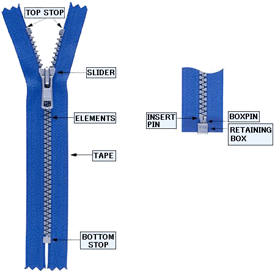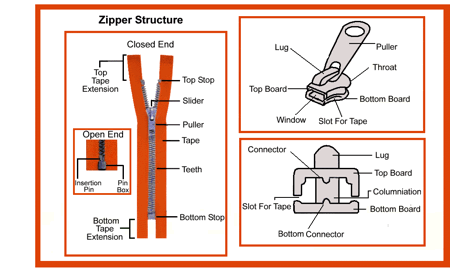Zipper – fasteners on garments
The zipper is a popular device which acts as a fastener for temporarily joining two edges of the fabric. The zipper is a part of the everyday costume. Also called slide fastener. a device used for fastening clothing, valises, etc., consisting of two toothed tracks or spiral metal or plastic coils, each bordering one of two edges to be joined, and a piece that either interlocks or separates them when pulled.
 The zipper is a popular device which acts as a fastener for temporarily joining two edges of the fabric. A zipper is made from three major components namely Tape, Slider, and Elements. In most of the daily needs, there is the usage of zippers. It is used in clothing, luggage, sporting goods, camping gear and other daily use items.
The zipper is a popular device which acts as a fastener for temporarily joining two edges of the fabric. A zipper is made from three major components namely Tape, Slider, and Elements. In most of the daily needs, there is the usage of zippers. It is used in clothing, luggage, sporting goods, camping gear and other daily use items.
SLIDER
The slider joins or separates the elements when the zipper is opened or closed. Various types of sliders are available depending on use.
ELEMENTS
The teeth, also known as elements, are the parts on each side of a zipper that mesh, or engage, with each other when passed through the slider. When the left and the right side teeth are engaged they are called chain.
TAPE
The tape is manufactured exclusively for zippers. It is usually made of polyester, but depending on use, synthetic fiber tape, vinyl tape, and cotton tape are also available.
Care and precautions for the zipper
Ironing: Durability of the zipper will be maintained if using appropriate temperature of iron while ironing zipper. Zipper must be closed and slider at the proper position and covered by a piece of cloth when ironing.
Staining: Copper alloy zippers may turn black due to ally oxidation after industrial washing and this can stain the fabric of garments. To avoid this, garment after industrial washing must be immediately rinsed and dried.
Cleaning: Zippers must be cleaned while closed. Strong alkaline detergents or chlorine bleaching agents must be used properly. A test must be done before bulk usage to avoid discoloration.
Anti Nickel: Zippers made from nickel alloy can cause irritation to the skin to some depending on sensitiveness of their skin.
Bio-Treatments: some types can corrode if cleansed using bio-treatments, therefore, tests must be done prior using in bulk wash.
Industrial washing with usage of various chemicals and washing agents sometimes zipper teeth can change color. Tests must be done before bulk wash.
Color Migration: Sometimes if garments are not properly stored in normal conditions color migration can take place from zipper tape or elements to fabrics like PVC fabrics, synthetic leather or coated fabrics. A thin tissue paper must be inserted between zippers and fabric when packing or storing.
Anatomy of Zippers

| Name | Description |
|---|---|
| Automatic Lock Slider | A slider that can provide locking action on the chain |
| Bead | An enlarged section situated on the inner edge of the tape for the affixing of the inter-lockable elements |
| Bottom Assembly | The components located at the lowest of the slide fastener which can provide feasibility to the slide fastener whether it is separable or nonseparable. |
| Bottom Stop | A component which fixed on both tapes, just below, or over the chain provides the functions to prevent the slider slipping away from the chain and to hold the tapes together at the bottom. |
| Bridge Top Stop | A component which locates just above the chain, provides a function to hold the tops of two stingers together and prevents the slider slipping away from the chain. |
| Cam Lock Slider | A slider that can provide a locking action when the curved projection on the pull extends through the window and presses against the elements. |
| Chain Thickness | The distance measured from front to back of the chain. |
| Chain Width | The distance measured between the shoulders of elements or between the outside edges of the bead if the bead situates beyond the elements. |
| Continuous Element | A chain of elements formed continuously along with the monofilament. |
| Continuous Element Zipper | A zipper is made up of two continuously formed elements located on the opposite edges of the tapes along which the elements are engaged and disengaged by moving the slider up and down. |
| Cord | Several yarns are combined in form of a strand in producing a bead. |
| Exposed Tape Width | The distance of the tape measured from the shoulders of the elements to the outer edge of the tape. |
| Fixed Retainer | A component situated at the bottom of the tape is always affixed to the retainer pin. |
| Mouth | The opening of the slider of which the elements enter into or leave the slider |
| Mouth Width | The distance measured between the slider flanges< |
| Movable Retainer | A retainer which is similar to a fixed retainer except it can move along the tape. Thus, the tape can be separated by moving the retainer upwards from the bottom without moving the slider downwards from the top. |
| Nonseparable Zipper | A zipper of which the two stringers cannot be separated due to the two stringers attached to each other at one or both ends. |
| Pin Lock Slider | A slider which has a projection on the pull and when the slider is in the locking position, the projection will rest between two adjacent elements |
| Separable Pin | A pin affixed to the bead at the bottom of one tape. |
| Separable Zipper | A zipper equipped with the separable pin and retainer at the bottom of the chain, thus the two stringers of the zipper can be completely disengaged and re-engaged. |
| Stop | The components, located at the top and bottom of the chain, are used to prevent the slider slipping away from the chain. |
| Stringer | One side of the chain which composes of the tape, bead, and elements. |
| Chain | The continuous piece that is formed when both halves of a zipper mesh together. |
| Chain Size | Refers to the specific gauge of the chain, i.e. size of the teeth. |
| Teeth | The individual elements that make up the chain.It is affixed along the edge of the tape and is used for interlocking |
| Slider | The device that moves up and down the chain to open or close the zipper. |
| Pull Tab | The part of the slider that you hold to move the slider up or down |
| Material | Refers to the type of chain that is used in the construction of the zipper, such as metal chain, molded plastic chain or cull (nylon) chain. |
| Tape | The fabric part of the zipper. |
| Tape Width | Refers to the width of the fabric on one side only of the zipper chain. |
| Tape Ends | The fabric part of the zipper that extends beyond the teeth, at the top and or bottom of the chain. |
| Style | Refers to the manner in which the zipper is assembled for a particular application. |
| Top Stop | Two devices affixed to the bottom end of a zipper, to prevent the slider from coming off the chain. |
| Bottom Stop | A device similar to a bottom stop, used at the top end of a zipper to prevent each half of the zipper from separating. |
| Pin | A device used on aspirating (jacket type) zipper whose function is to allow the joining of the two zipper halves. |
| Box | A device used on a separating (jacket type) zipper whose function is to correctly align the pin. |
| Heat Seal Patch | The cotton any nylon laminated material fused to the bottom end of a separating zipper, used to reinforce the type. |
| Zipper | A slide fastener composed of two stringers with the inter-lockable elements attached to them. When the slider moves in one direction, it will cause the inter-lockable elements on the two stringers engage together and when the slider moves in opposite direction, it will cause the engaged inter-lockable elements disengaged. |


